Analyzing Knowledge Management in Manic Marketers: A Case Study
VerifiedAdded on 2023/06/12
|13
|3064
|106
Case Study
AI Summary
This case study analyzes the knowledge management practices at Manic Marketers, focusing on the knowledge environment, the role of a mentor, and the types of information and organizational knowledge used. It identifies key weaknesses in the social capital of the organization and proposes several knowledge-sharing strategies to improve overall efficiency and effectiveness. The report delves into how a new employee, Damon, navigates the organization's knowledge landscape and the challenges he faces in understanding internal processes and information. The analysis covers transaction processing systems, management information, and judgmental information, along with different forms of knowledge such as 'knowing what,' 'knowing who,' and 'knowing how.' The study concludes by recommending strategies such as client consideration and the use of simple language to enhance knowledge sharing within Manic Marketers.
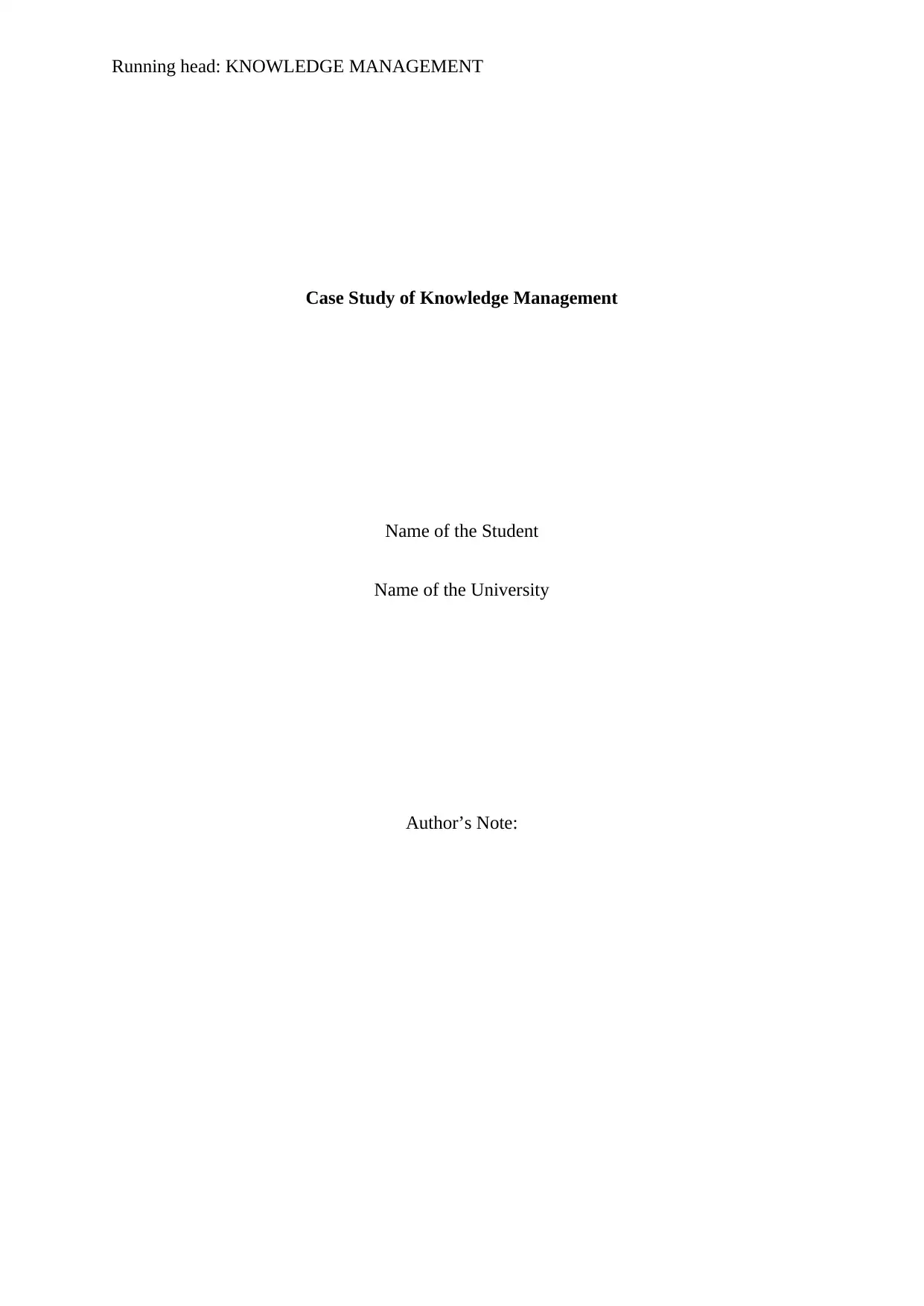
Running head: KNOWLEDGE MANAGEMENT
Case Study of Knowledge Management
Name of the Student
Name of the University
Author’s Note:
Case Study of Knowledge Management
Name of the Student
Name of the University
Author’s Note:
Paraphrase This Document
Need a fresh take? Get an instant paraphrase of this document with our AI Paraphraser
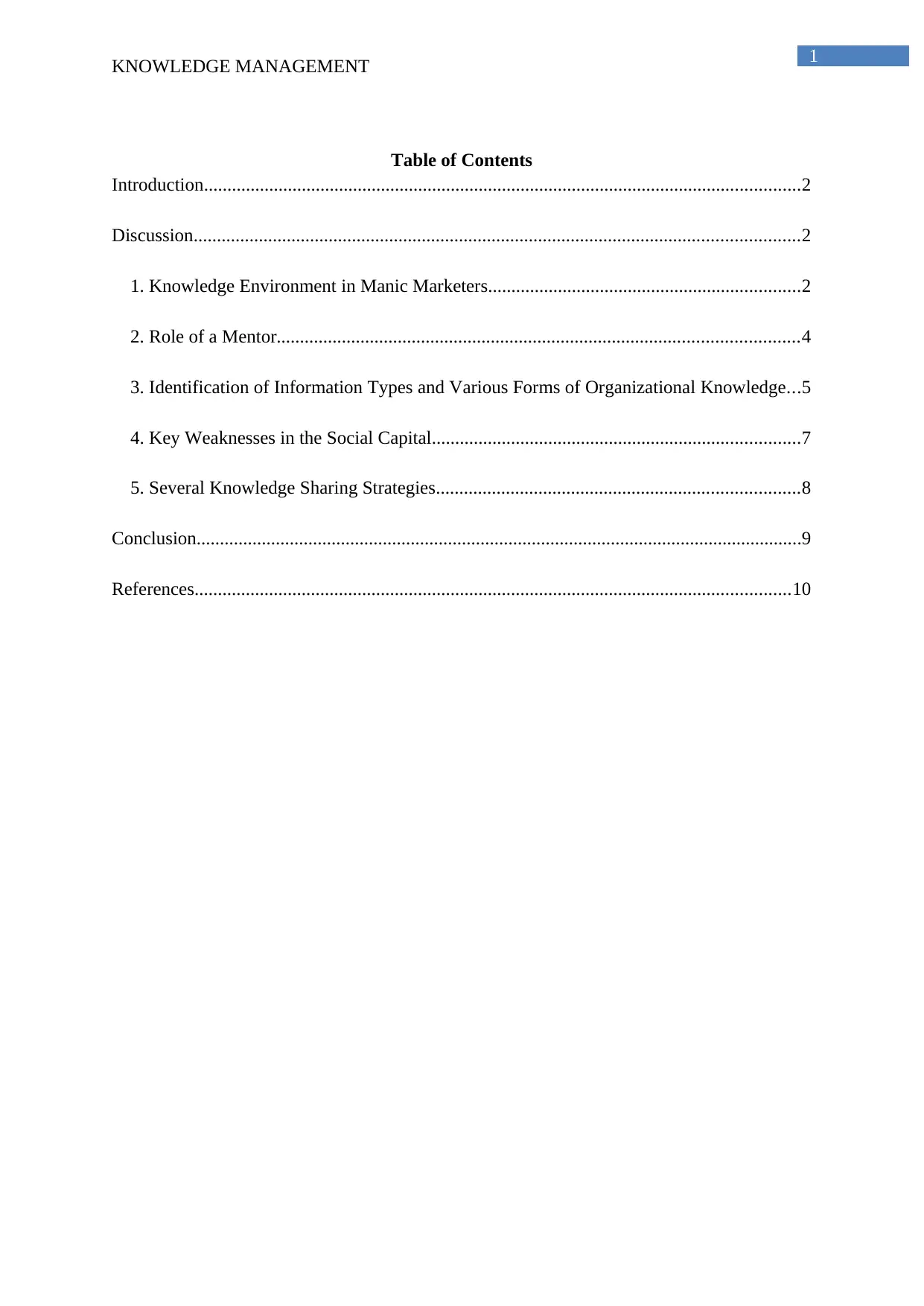
1
KNOWLEDGE MANAGEMENT
Table of Contents
Introduction................................................................................................................................2
Discussion..................................................................................................................................2
1. Knowledge Environment in Manic Marketers...................................................................2
2. Role of a Mentor................................................................................................................4
3. Identification of Information Types and Various Forms of Organizational Knowledge...5
4. Key Weaknesses in the Social Capital...............................................................................7
5. Several Knowledge Sharing Strategies..............................................................................8
Conclusion..................................................................................................................................9
References................................................................................................................................10
KNOWLEDGE MANAGEMENT
Table of Contents
Introduction................................................................................................................................2
Discussion..................................................................................................................................2
1. Knowledge Environment in Manic Marketers...................................................................2
2. Role of a Mentor................................................................................................................4
3. Identification of Information Types and Various Forms of Organizational Knowledge...5
4. Key Weaknesses in the Social Capital...............................................................................7
5. Several Knowledge Sharing Strategies..............................................................................8
Conclusion..................................................................................................................................9
References................................................................................................................................10
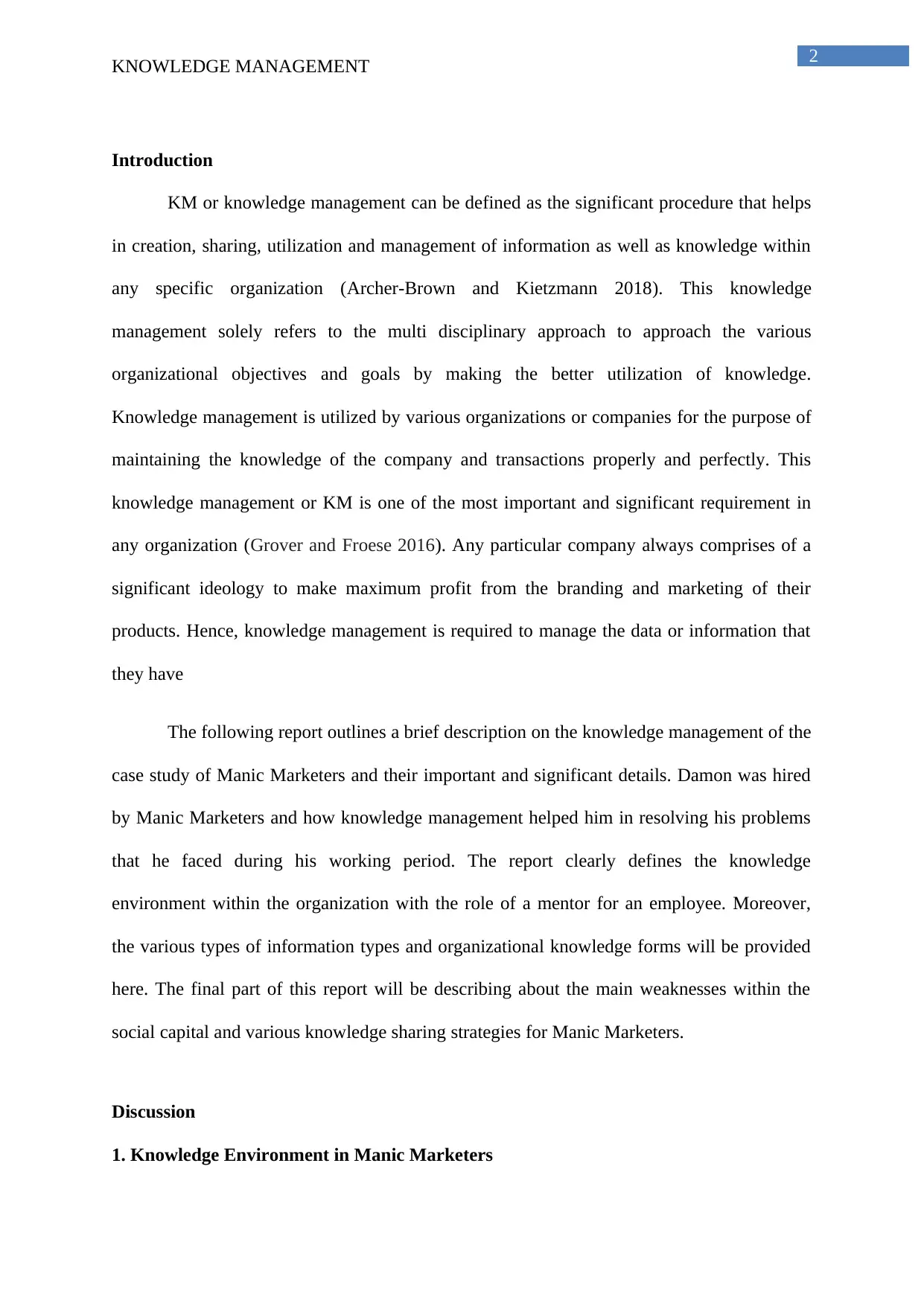
2
KNOWLEDGE MANAGEMENT
Introduction
KM or knowledge management can be defined as the significant procedure that helps
in creation, sharing, utilization and management of information as well as knowledge within
any specific organization (Archer-Brown and Kietzmann 2018). This knowledge
management solely refers to the multi disciplinary approach to approach the various
organizational objectives and goals by making the better utilization of knowledge.
Knowledge management is utilized by various organizations or companies for the purpose of
maintaining the knowledge of the company and transactions properly and perfectly. This
knowledge management or KM is one of the most important and significant requirement in
any organization (Grover and Froese 2016). Any particular company always comprises of a
significant ideology to make maximum profit from the branding and marketing of their
products. Hence, knowledge management is required to manage the data or information that
they have
The following report outlines a brief description on the knowledge management of the
case study of Manic Marketers and their important and significant details. Damon was hired
by Manic Marketers and how knowledge management helped him in resolving his problems
that he faced during his working period. The report clearly defines the knowledge
environment within the organization with the role of a mentor for an employee. Moreover,
the various types of information types and organizational knowledge forms will be provided
here. The final part of this report will be describing about the main weaknesses within the
social capital and various knowledge sharing strategies for Manic Marketers.
Discussion
1. Knowledge Environment in Manic Marketers
KNOWLEDGE MANAGEMENT
Introduction
KM or knowledge management can be defined as the significant procedure that helps
in creation, sharing, utilization and management of information as well as knowledge within
any specific organization (Archer-Brown and Kietzmann 2018). This knowledge
management solely refers to the multi disciplinary approach to approach the various
organizational objectives and goals by making the better utilization of knowledge.
Knowledge management is utilized by various organizations or companies for the purpose of
maintaining the knowledge of the company and transactions properly and perfectly. This
knowledge management or KM is one of the most important and significant requirement in
any organization (Grover and Froese 2016). Any particular company always comprises of a
significant ideology to make maximum profit from the branding and marketing of their
products. Hence, knowledge management is required to manage the data or information that
they have
The following report outlines a brief description on the knowledge management of the
case study of Manic Marketers and their important and significant details. Damon was hired
by Manic Marketers and how knowledge management helped him in resolving his problems
that he faced during his working period. The report clearly defines the knowledge
environment within the organization with the role of a mentor for an employee. Moreover,
the various types of information types and organizational knowledge forms will be provided
here. The final part of this report will be describing about the main weaknesses within the
social capital and various knowledge sharing strategies for Manic Marketers.
Discussion
1. Knowledge Environment in Manic Marketers
⊘ This is a preview!⊘
Do you want full access?
Subscribe today to unlock all pages.

Trusted by 1+ million students worldwide
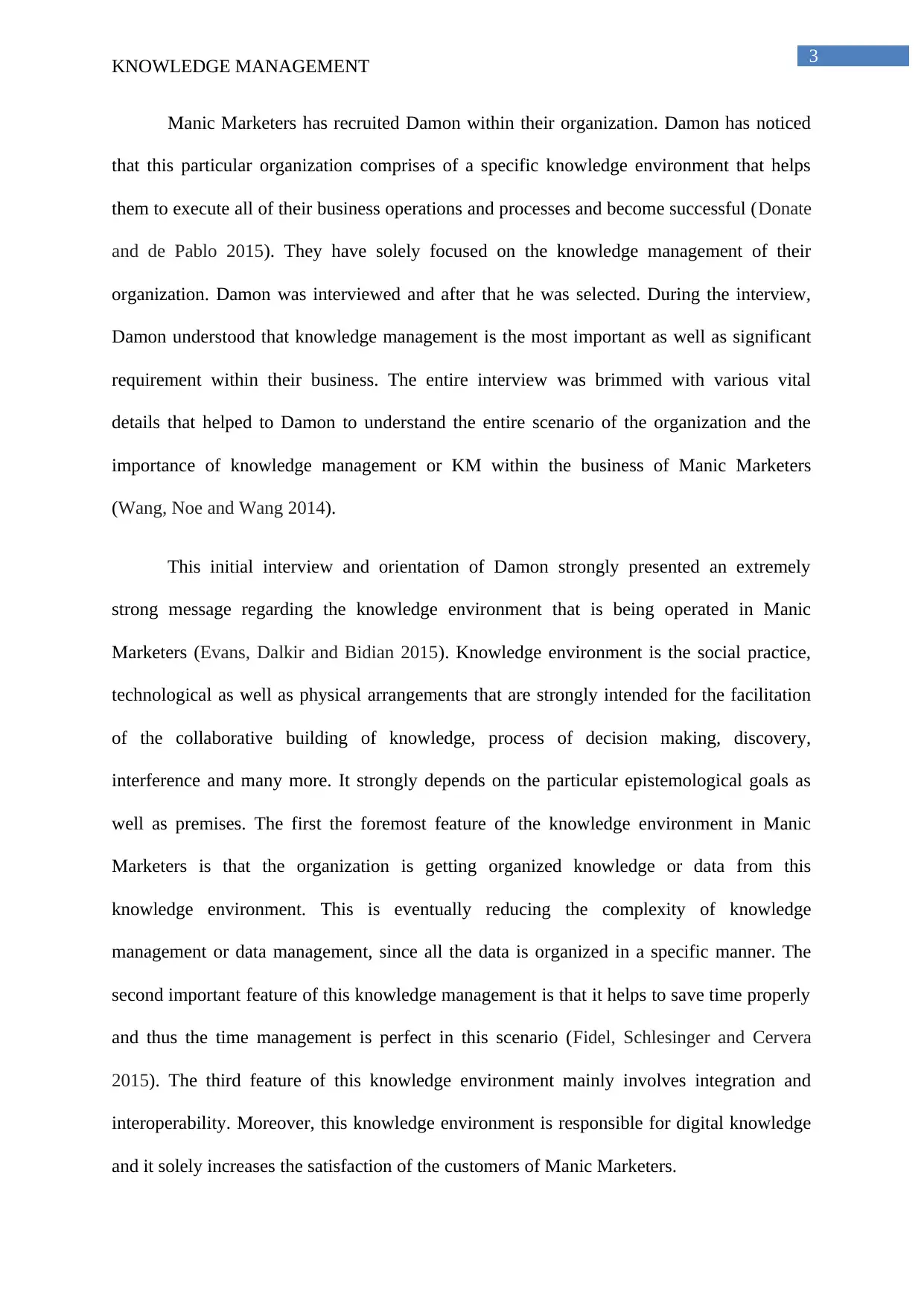
3
KNOWLEDGE MANAGEMENT
Manic Marketers has recruited Damon within their organization. Damon has noticed
that this particular organization comprises of a specific knowledge environment that helps
them to execute all of their business operations and processes and become successful (Donate
and de Pablo 2015). They have solely focused on the knowledge management of their
organization. Damon was interviewed and after that he was selected. During the interview,
Damon understood that knowledge management is the most important as well as significant
requirement within their business. The entire interview was brimmed with various vital
details that helped to Damon to understand the entire scenario of the organization and the
importance of knowledge management or KM within the business of Manic Marketers
(Wang, Noe and Wang 2014).
This initial interview and orientation of Damon strongly presented an extremely
strong message regarding the knowledge environment that is being operated in Manic
Marketers (Evans, Dalkir and Bidian 2015). Knowledge environment is the social practice,
technological as well as physical arrangements that are strongly intended for the facilitation
of the collaborative building of knowledge, process of decision making, discovery,
interference and many more. It strongly depends on the particular epistemological goals as
well as premises. The first the foremost feature of the knowledge environment in Manic
Marketers is that the organization is getting organized knowledge or data from this
knowledge environment. This is eventually reducing the complexity of knowledge
management or data management, since all the data is organized in a specific manner. The
second important feature of this knowledge management is that it helps to save time properly
and thus the time management is perfect in this scenario (Fidel, Schlesinger and Cervera
2015). The third feature of this knowledge environment mainly involves integration and
interoperability. Moreover, this knowledge environment is responsible for digital knowledge
and it solely increases the satisfaction of the customers of Manic Marketers.
KNOWLEDGE MANAGEMENT
Manic Marketers has recruited Damon within their organization. Damon has noticed
that this particular organization comprises of a specific knowledge environment that helps
them to execute all of their business operations and processes and become successful (Donate
and de Pablo 2015). They have solely focused on the knowledge management of their
organization. Damon was interviewed and after that he was selected. During the interview,
Damon understood that knowledge management is the most important as well as significant
requirement within their business. The entire interview was brimmed with various vital
details that helped to Damon to understand the entire scenario of the organization and the
importance of knowledge management or KM within the business of Manic Marketers
(Wang, Noe and Wang 2014).
This initial interview and orientation of Damon strongly presented an extremely
strong message regarding the knowledge environment that is being operated in Manic
Marketers (Evans, Dalkir and Bidian 2015). Knowledge environment is the social practice,
technological as well as physical arrangements that are strongly intended for the facilitation
of the collaborative building of knowledge, process of decision making, discovery,
interference and many more. It strongly depends on the particular epistemological goals as
well as premises. The first the foremost feature of the knowledge environment in Manic
Marketers is that the organization is getting organized knowledge or data from this
knowledge environment. This is eventually reducing the complexity of knowledge
management or data management, since all the data is organized in a specific manner. The
second important feature of this knowledge management is that it helps to save time properly
and thus the time management is perfect in this scenario (Fidel, Schlesinger and Cervera
2015). The third feature of this knowledge environment mainly involves integration and
interoperability. Moreover, this knowledge environment is responsible for digital knowledge
and it solely increases the satisfaction of the customers of Manic Marketers.
Paraphrase This Document
Need a fresh take? Get an instant paraphrase of this document with our AI Paraphraser
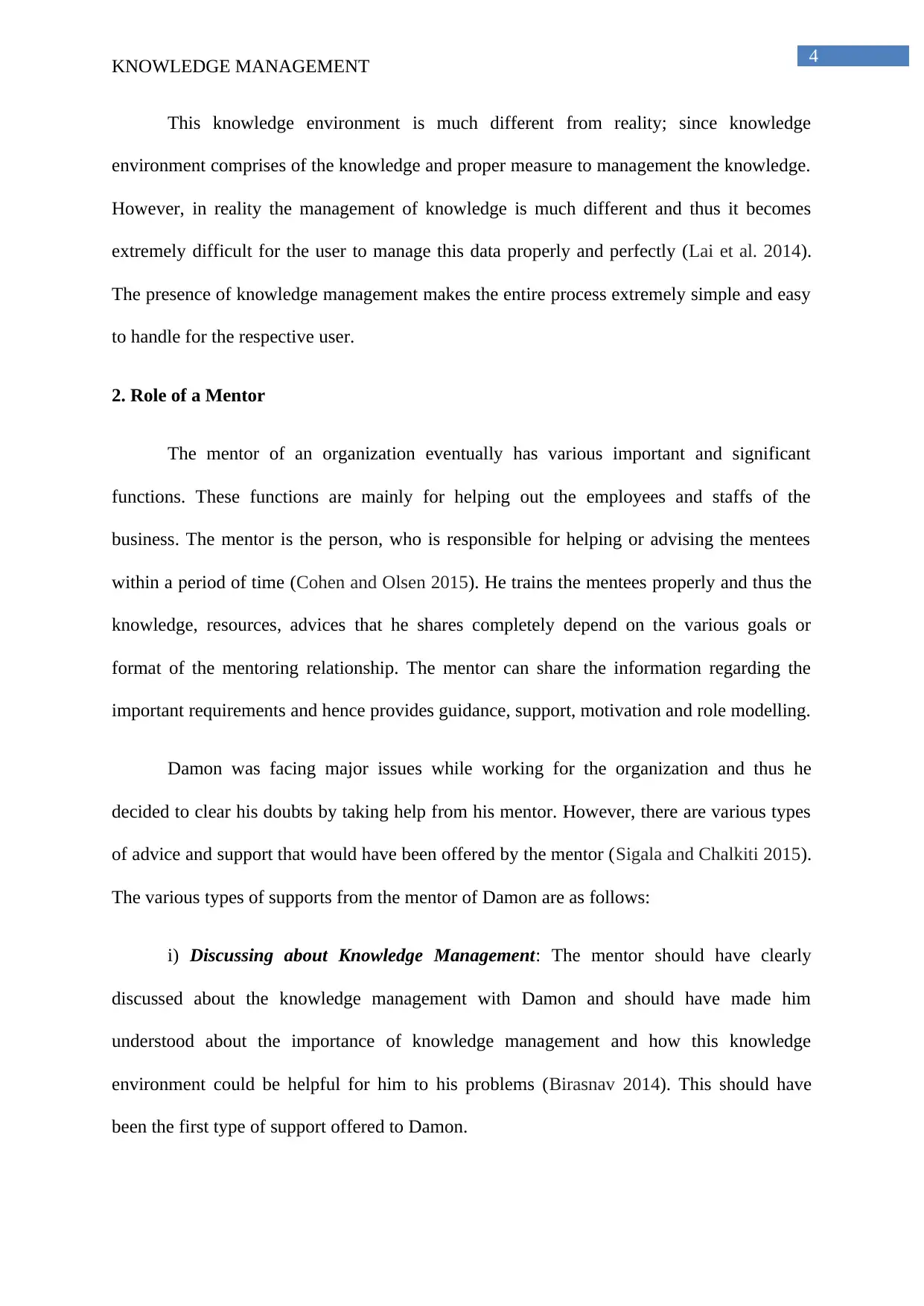
4
KNOWLEDGE MANAGEMENT
This knowledge environment is much different from reality; since knowledge
environment comprises of the knowledge and proper measure to management the knowledge.
However, in reality the management of knowledge is much different and thus it becomes
extremely difficult for the user to manage this data properly and perfectly (Lai et al. 2014).
The presence of knowledge management makes the entire process extremely simple and easy
to handle for the respective user.
2. Role of a Mentor
The mentor of an organization eventually has various important and significant
functions. These functions are mainly for helping out the employees and staffs of the
business. The mentor is the person, who is responsible for helping or advising the mentees
within a period of time (Cohen and Olsen 2015). He trains the mentees properly and thus the
knowledge, resources, advices that he shares completely depend on the various goals or
format of the mentoring relationship. The mentor can share the information regarding the
important requirements and hence provides guidance, support, motivation and role modelling.
Damon was facing major issues while working for the organization and thus he
decided to clear his doubts by taking help from his mentor. However, there are various types
of advice and support that would have been offered by the mentor (Sigala and Chalkiti 2015).
The various types of supports from the mentor of Damon are as follows:
i) Discussing about Knowledge Management: The mentor should have clearly
discussed about the knowledge management with Damon and should have made him
understood about the importance of knowledge management and how this knowledge
environment could be helpful for him to his problems (Birasnav 2014). This should have
been the first type of support offered to Damon.
KNOWLEDGE MANAGEMENT
This knowledge environment is much different from reality; since knowledge
environment comprises of the knowledge and proper measure to management the knowledge.
However, in reality the management of knowledge is much different and thus it becomes
extremely difficult for the user to manage this data properly and perfectly (Lai et al. 2014).
The presence of knowledge management makes the entire process extremely simple and easy
to handle for the respective user.
2. Role of a Mentor
The mentor of an organization eventually has various important and significant
functions. These functions are mainly for helping out the employees and staffs of the
business. The mentor is the person, who is responsible for helping or advising the mentees
within a period of time (Cohen and Olsen 2015). He trains the mentees properly and thus the
knowledge, resources, advices that he shares completely depend on the various goals or
format of the mentoring relationship. The mentor can share the information regarding the
important requirements and hence provides guidance, support, motivation and role modelling.
Damon was facing major issues while working for the organization and thus he
decided to clear his doubts by taking help from his mentor. However, there are various types
of advice and support that would have been offered by the mentor (Sigala and Chalkiti 2015).
The various types of supports from the mentor of Damon are as follows:
i) Discussing about Knowledge Management: The mentor should have clearly
discussed about the knowledge management with Damon and should have made him
understood about the importance of knowledge management and how this knowledge
environment could be helpful for him to his problems (Birasnav 2014). This should have
been the first type of support offered to Damon.
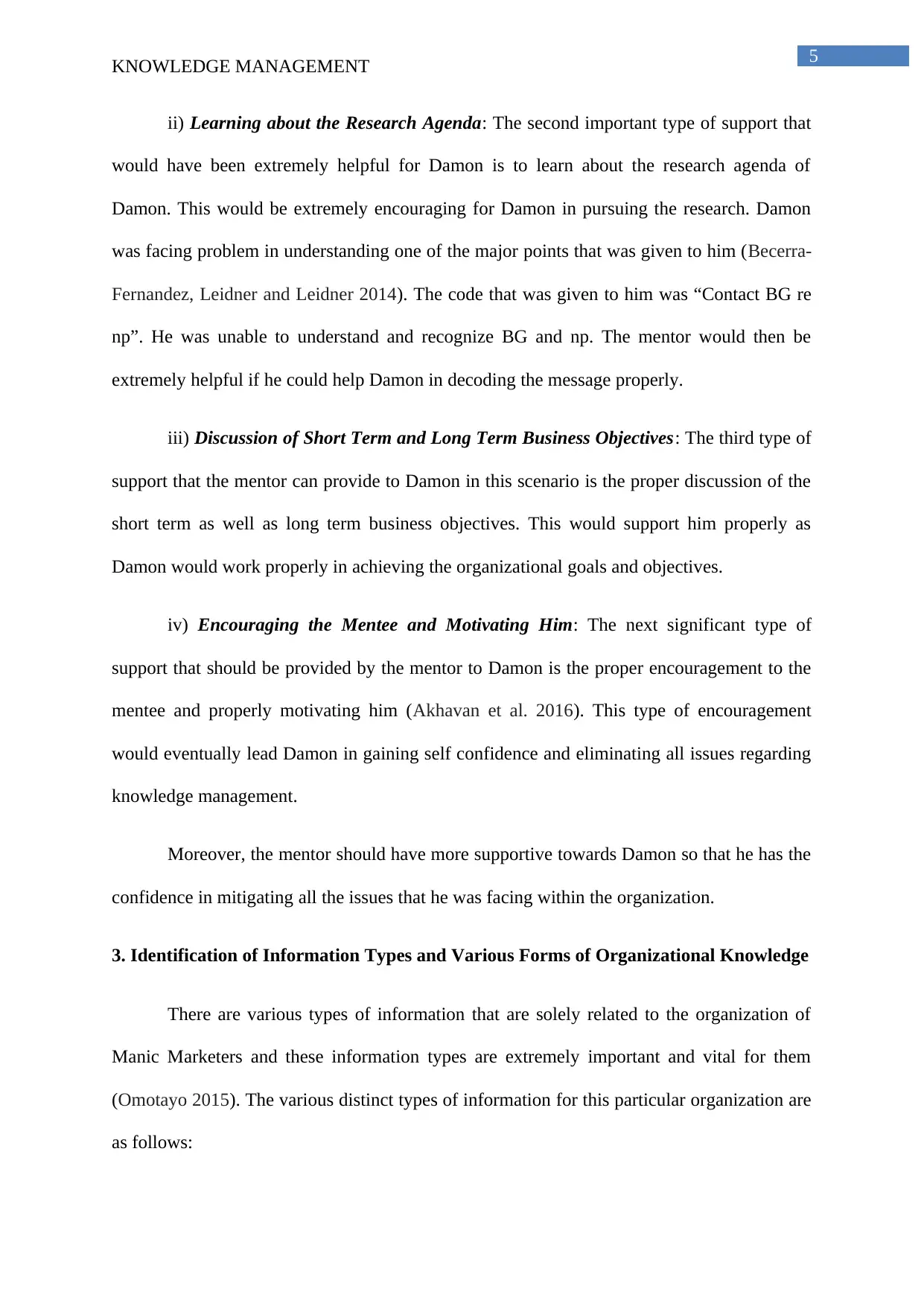
5
KNOWLEDGE MANAGEMENT
ii) Learning about the Research Agenda: The second important type of support that
would have been extremely helpful for Damon is to learn about the research agenda of
Damon. This would be extremely encouraging for Damon in pursuing the research. Damon
was facing problem in understanding one of the major points that was given to him (Becerra-
Fernandez, Leidner and Leidner 2014). The code that was given to him was “Contact BG re
np”. He was unable to understand and recognize BG and np. The mentor would then be
extremely helpful if he could help Damon in decoding the message properly.
iii) Discussion of Short Term and Long Term Business Objectives: The third type of
support that the mentor can provide to Damon in this scenario is the proper discussion of the
short term as well as long term business objectives. This would support him properly as
Damon would work properly in achieving the organizational goals and objectives.
iv) Encouraging the Mentee and Motivating Him: The next significant type of
support that should be provided by the mentor to Damon is the proper encouragement to the
mentee and properly motivating him (Akhavan et al. 2016). This type of encouragement
would eventually lead Damon in gaining self confidence and eliminating all issues regarding
knowledge management.
Moreover, the mentor should have more supportive towards Damon so that he has the
confidence in mitigating all the issues that he was facing within the organization.
3. Identification of Information Types and Various Forms of Organizational Knowledge
There are various types of information that are solely related to the organization of
Manic Marketers and these information types are extremely important and vital for them
(Omotayo 2015). The various distinct types of information for this particular organization are
as follows:
KNOWLEDGE MANAGEMENT
ii) Learning about the Research Agenda: The second important type of support that
would have been extremely helpful for Damon is to learn about the research agenda of
Damon. This would be extremely encouraging for Damon in pursuing the research. Damon
was facing problem in understanding one of the major points that was given to him (Becerra-
Fernandez, Leidner and Leidner 2014). The code that was given to him was “Contact BG re
np”. He was unable to understand and recognize BG and np. The mentor would then be
extremely helpful if he could help Damon in decoding the message properly.
iii) Discussion of Short Term and Long Term Business Objectives: The third type of
support that the mentor can provide to Damon in this scenario is the proper discussion of the
short term as well as long term business objectives. This would support him properly as
Damon would work properly in achieving the organizational goals and objectives.
iv) Encouraging the Mentee and Motivating Him: The next significant type of
support that should be provided by the mentor to Damon is the proper encouragement to the
mentee and properly motivating him (Akhavan et al. 2016). This type of encouragement
would eventually lead Damon in gaining self confidence and eliminating all issues regarding
knowledge management.
Moreover, the mentor should have more supportive towards Damon so that he has the
confidence in mitigating all the issues that he was facing within the organization.
3. Identification of Information Types and Various Forms of Organizational Knowledge
There are various types of information that are solely related to the organization of
Manic Marketers and these information types are extremely important and vital for them
(Omotayo 2015). The various distinct types of information for this particular organization are
as follows:
⊘ This is a preview!⊘
Do you want full access?
Subscribe today to unlock all pages.

Trusted by 1+ million students worldwide
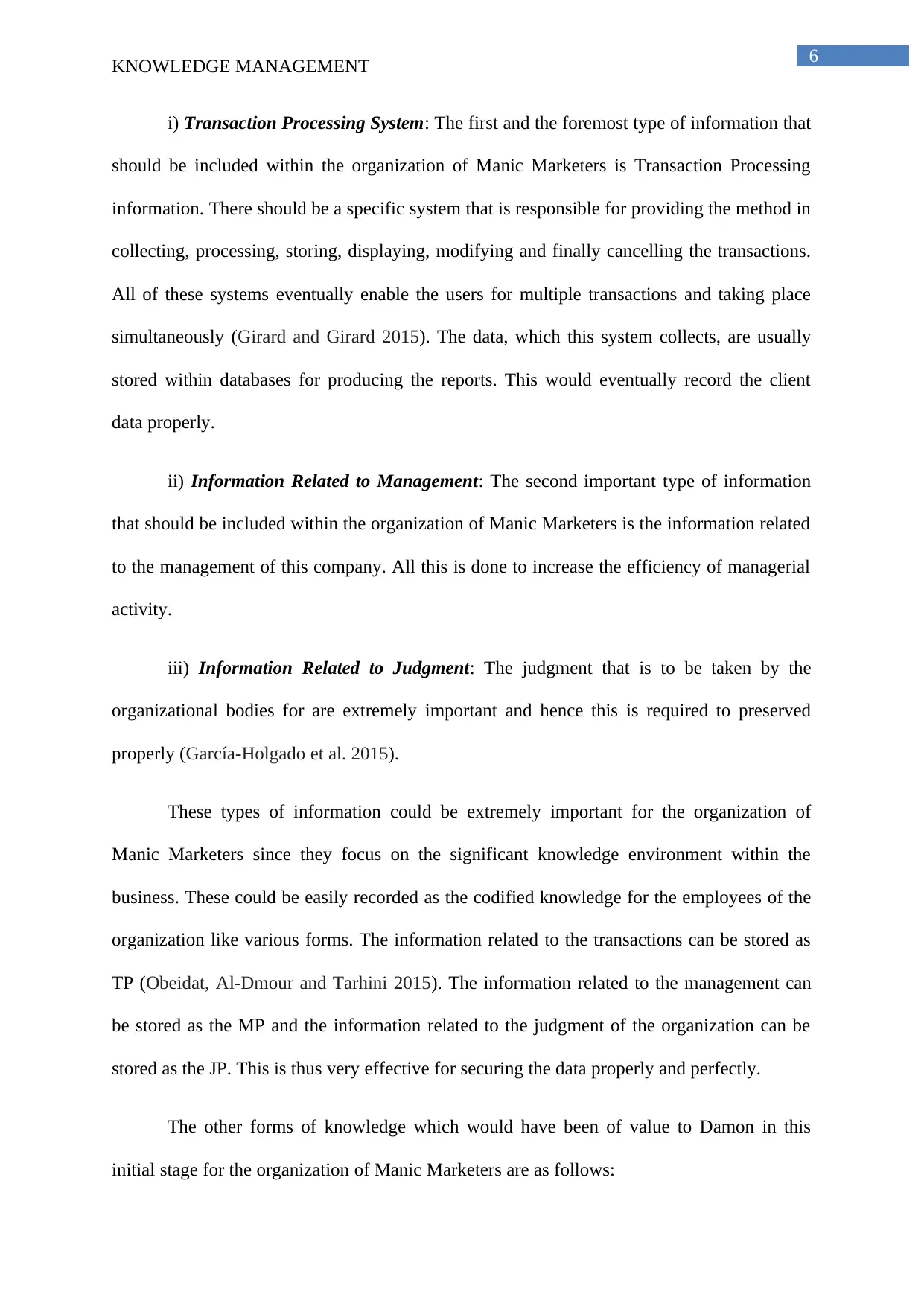
6
KNOWLEDGE MANAGEMENT
i) Transaction Processing System: The first and the foremost type of information that
should be included within the organization of Manic Marketers is Transaction Processing
information. There should be a specific system that is responsible for providing the method in
collecting, processing, storing, displaying, modifying and finally cancelling the transactions.
All of these systems eventually enable the users for multiple transactions and taking place
simultaneously (Girard and Girard 2015). The data, which this system collects, are usually
stored within databases for producing the reports. This would eventually record the client
data properly.
ii) Information Related to Management: The second important type of information
that should be included within the organization of Manic Marketers is the information related
to the management of this company. All this is done to increase the efficiency of managerial
activity.
iii) Information Related to Judgment: The judgment that is to be taken by the
organizational bodies for are extremely important and hence this is required to preserved
properly (García-Holgado et al. 2015).
These types of information could be extremely important for the organization of
Manic Marketers since they focus on the significant knowledge environment within the
business. These could be easily recorded as the codified knowledge for the employees of the
organization like various forms. The information related to the transactions can be stored as
TP (Obeidat, Al-Dmour and Tarhini 2015). The information related to the management can
be stored as the MP and the information related to the judgment of the organization can be
stored as the JP. This is thus very effective for securing the data properly and perfectly.
The other forms of knowledge which would have been of value to Damon in this
initial stage for the organization of Manic Marketers are as follows:
KNOWLEDGE MANAGEMENT
i) Transaction Processing System: The first and the foremost type of information that
should be included within the organization of Manic Marketers is Transaction Processing
information. There should be a specific system that is responsible for providing the method in
collecting, processing, storing, displaying, modifying and finally cancelling the transactions.
All of these systems eventually enable the users for multiple transactions and taking place
simultaneously (Girard and Girard 2015). The data, which this system collects, are usually
stored within databases for producing the reports. This would eventually record the client
data properly.
ii) Information Related to Management: The second important type of information
that should be included within the organization of Manic Marketers is the information related
to the management of this company. All this is done to increase the efficiency of managerial
activity.
iii) Information Related to Judgment: The judgment that is to be taken by the
organizational bodies for are extremely important and hence this is required to preserved
properly (García-Holgado et al. 2015).
These types of information could be extremely important for the organization of
Manic Marketers since they focus on the significant knowledge environment within the
business. These could be easily recorded as the codified knowledge for the employees of the
organization like various forms. The information related to the transactions can be stored as
TP (Obeidat, Al-Dmour and Tarhini 2015). The information related to the management can
be stored as the MP and the information related to the judgment of the organization can be
stored as the JP. This is thus very effective for securing the data properly and perfectly.
The other forms of knowledge which would have been of value to Damon in this
initial stage for the organization of Manic Marketers are as follows:
Paraphrase This Document
Need a fresh take? Get an instant paraphrase of this document with our AI Paraphraser
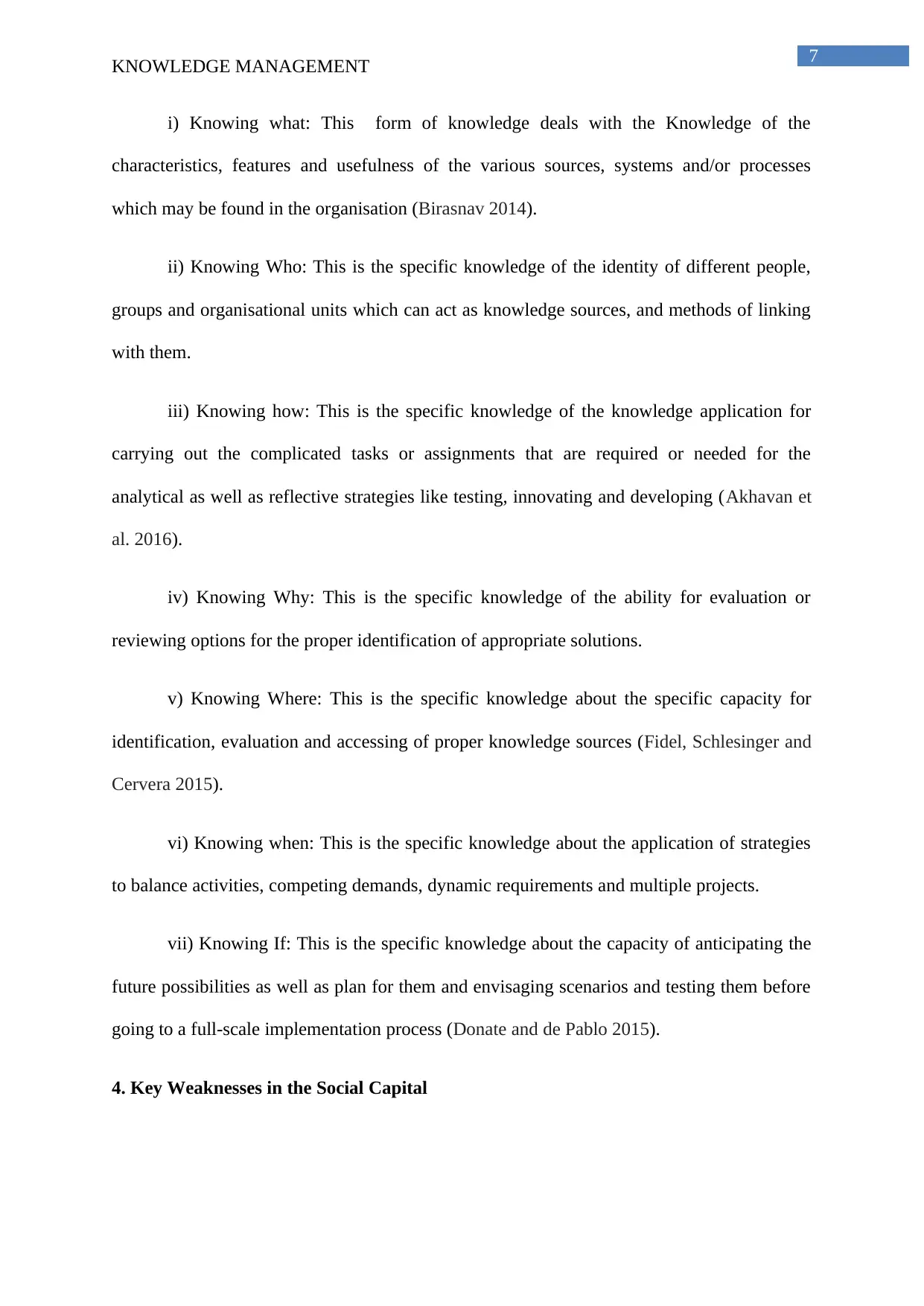
7
KNOWLEDGE MANAGEMENT
i) Knowing what: This form of knowledge deals with the Knowledge of the
characteristics, features and usefulness of the various sources, systems and/or processes
which may be found in the organisation (Birasnav 2014).
ii) Knowing Who: This is the specific knowledge of the identity of different people,
groups and organisational units which can act as knowledge sources, and methods of linking
with them.
iii) Knowing how: This is the specific knowledge of the knowledge application for
carrying out the complicated tasks or assignments that are required or needed for the
analytical as well as reflective strategies like testing, innovating and developing (Akhavan et
al. 2016).
iv) Knowing Why: This is the specific knowledge of the ability for evaluation or
reviewing options for the proper identification of appropriate solutions.
v) Knowing Where: This is the specific knowledge about the specific capacity for
identification, evaluation and accessing of proper knowledge sources (Fidel, Schlesinger and
Cervera 2015).
vi) Knowing when: This is the specific knowledge about the application of strategies
to balance activities, competing demands, dynamic requirements and multiple projects.
vii) Knowing If: This is the specific knowledge about the capacity of anticipating the
future possibilities as well as plan for them and envisaging scenarios and testing them before
going to a full-scale implementation process (Donate and de Pablo 2015).
4. Key Weaknesses in the Social Capital
KNOWLEDGE MANAGEMENT
i) Knowing what: This form of knowledge deals with the Knowledge of the
characteristics, features and usefulness of the various sources, systems and/or processes
which may be found in the organisation (Birasnav 2014).
ii) Knowing Who: This is the specific knowledge of the identity of different people,
groups and organisational units which can act as knowledge sources, and methods of linking
with them.
iii) Knowing how: This is the specific knowledge of the knowledge application for
carrying out the complicated tasks or assignments that are required or needed for the
analytical as well as reflective strategies like testing, innovating and developing (Akhavan et
al. 2016).
iv) Knowing Why: This is the specific knowledge of the ability for evaluation or
reviewing options for the proper identification of appropriate solutions.
v) Knowing Where: This is the specific knowledge about the specific capacity for
identification, evaluation and accessing of proper knowledge sources (Fidel, Schlesinger and
Cervera 2015).
vi) Knowing when: This is the specific knowledge about the application of strategies
to balance activities, competing demands, dynamic requirements and multiple projects.
vii) Knowing If: This is the specific knowledge about the capacity of anticipating the
future possibilities as well as plan for them and envisaging scenarios and testing them before
going to a full-scale implementation process (Donate and de Pablo 2015).
4. Key Weaknesses in the Social Capital
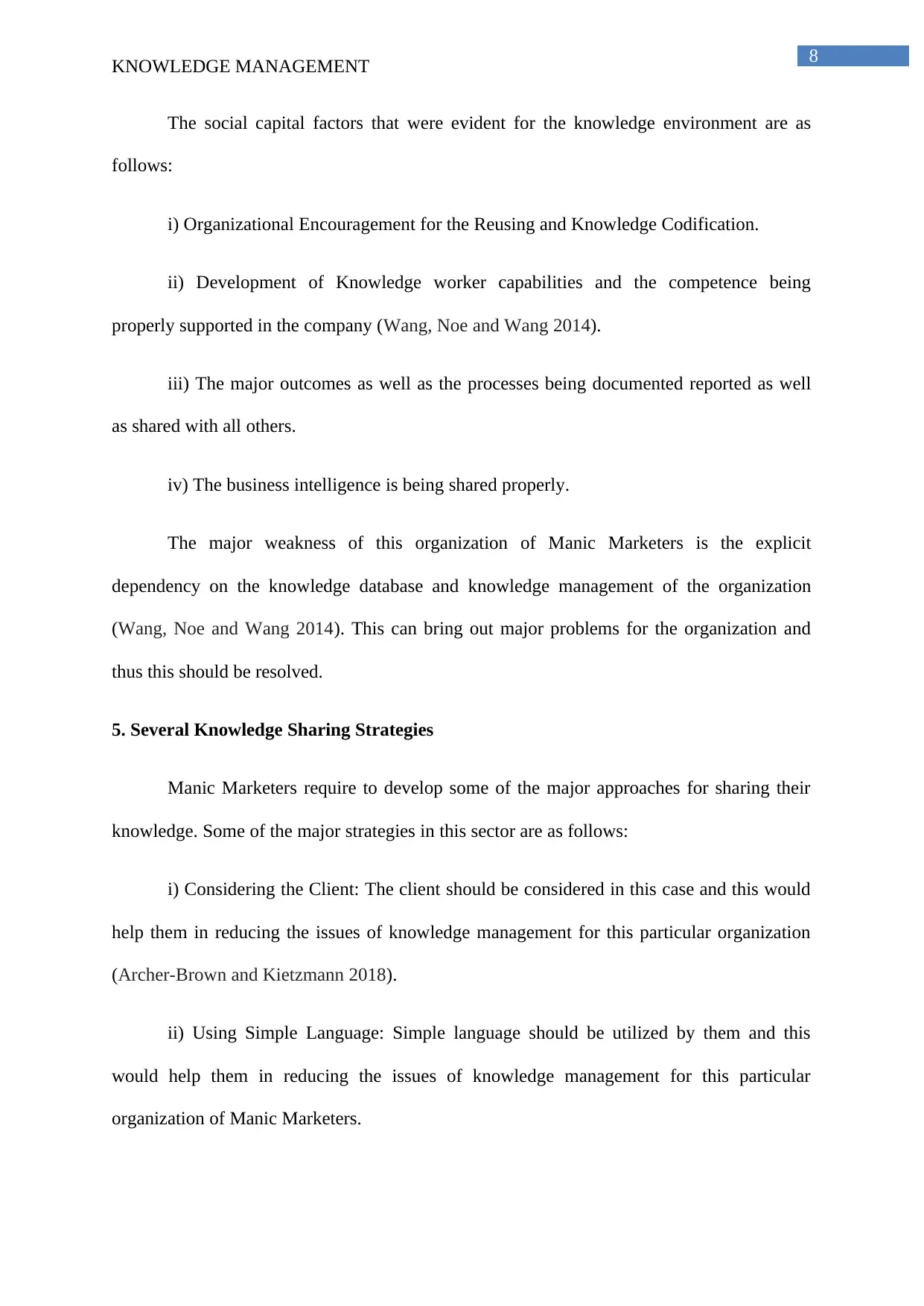
8
KNOWLEDGE MANAGEMENT
The social capital factors that were evident for the knowledge environment are as
follows:
i) Organizational Encouragement for the Reusing and Knowledge Codification.
ii) Development of Knowledge worker capabilities and the competence being
properly supported in the company (Wang, Noe and Wang 2014).
iii) The major outcomes as well as the processes being documented reported as well
as shared with all others.
iv) The business intelligence is being shared properly.
The major weakness of this organization of Manic Marketers is the explicit
dependency on the knowledge database and knowledge management of the organization
(Wang, Noe and Wang 2014). This can bring out major problems for the organization and
thus this should be resolved.
5. Several Knowledge Sharing Strategies
Manic Marketers require to develop some of the major approaches for sharing their
knowledge. Some of the major strategies in this sector are as follows:
i) Considering the Client: The client should be considered in this case and this would
help them in reducing the issues of knowledge management for this particular organization
(Archer-Brown and Kietzmann 2018).
ii) Using Simple Language: Simple language should be utilized by them and this
would help them in reducing the issues of knowledge management for this particular
organization of Manic Marketers.
KNOWLEDGE MANAGEMENT
The social capital factors that were evident for the knowledge environment are as
follows:
i) Organizational Encouragement for the Reusing and Knowledge Codification.
ii) Development of Knowledge worker capabilities and the competence being
properly supported in the company (Wang, Noe and Wang 2014).
iii) The major outcomes as well as the processes being documented reported as well
as shared with all others.
iv) The business intelligence is being shared properly.
The major weakness of this organization of Manic Marketers is the explicit
dependency on the knowledge database and knowledge management of the organization
(Wang, Noe and Wang 2014). This can bring out major problems for the organization and
thus this should be resolved.
5. Several Knowledge Sharing Strategies
Manic Marketers require to develop some of the major approaches for sharing their
knowledge. Some of the major strategies in this sector are as follows:
i) Considering the Client: The client should be considered in this case and this would
help them in reducing the issues of knowledge management for this particular organization
(Archer-Brown and Kietzmann 2018).
ii) Using Simple Language: Simple language should be utilized by them and this
would help them in reducing the issues of knowledge management for this particular
organization of Manic Marketers.
⊘ This is a preview!⊘
Do you want full access?
Subscribe today to unlock all pages.

Trusted by 1+ million students worldwide
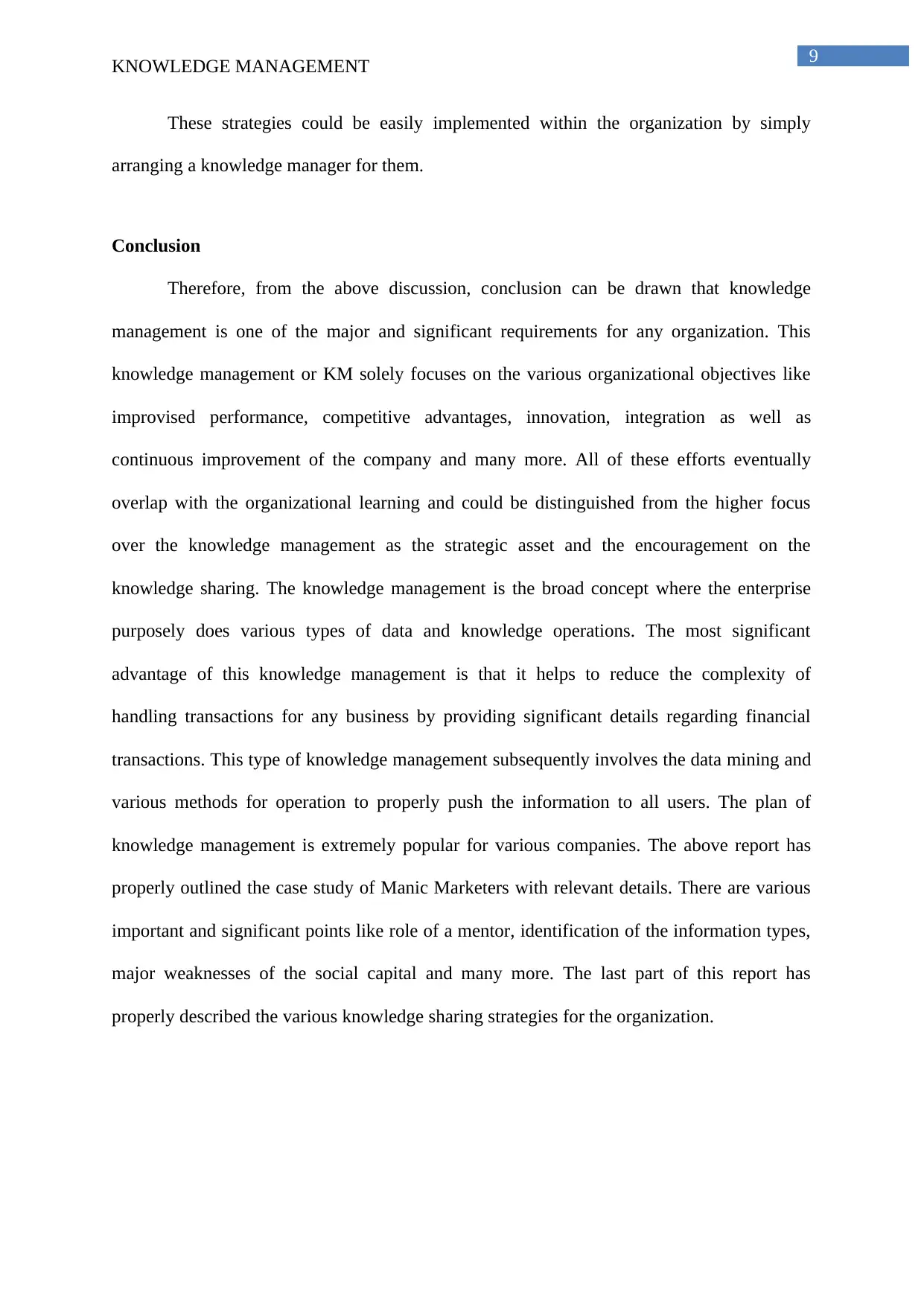
9
KNOWLEDGE MANAGEMENT
These strategies could be easily implemented within the organization by simply
arranging a knowledge manager for them.
Conclusion
Therefore, from the above discussion, conclusion can be drawn that knowledge
management is one of the major and significant requirements for any organization. This
knowledge management or KM solely focuses on the various organizational objectives like
improvised performance, competitive advantages, innovation, integration as well as
continuous improvement of the company and many more. All of these efforts eventually
overlap with the organizational learning and could be distinguished from the higher focus
over the knowledge management as the strategic asset and the encouragement on the
knowledge sharing. The knowledge management is the broad concept where the enterprise
purposely does various types of data and knowledge operations. The most significant
advantage of this knowledge management is that it helps to reduce the complexity of
handling transactions for any business by providing significant details regarding financial
transactions. This type of knowledge management subsequently involves the data mining and
various methods for operation to properly push the information to all users. The plan of
knowledge management is extremely popular for various companies. The above report has
properly outlined the case study of Manic Marketers with relevant details. There are various
important and significant points like role of a mentor, identification of the information types,
major weaknesses of the social capital and many more. The last part of this report has
properly described the various knowledge sharing strategies for the organization.
KNOWLEDGE MANAGEMENT
These strategies could be easily implemented within the organization by simply
arranging a knowledge manager for them.
Conclusion
Therefore, from the above discussion, conclusion can be drawn that knowledge
management is one of the major and significant requirements for any organization. This
knowledge management or KM solely focuses on the various organizational objectives like
improvised performance, competitive advantages, innovation, integration as well as
continuous improvement of the company and many more. All of these efforts eventually
overlap with the organizational learning and could be distinguished from the higher focus
over the knowledge management as the strategic asset and the encouragement on the
knowledge sharing. The knowledge management is the broad concept where the enterprise
purposely does various types of data and knowledge operations. The most significant
advantage of this knowledge management is that it helps to reduce the complexity of
handling transactions for any business by providing significant details regarding financial
transactions. This type of knowledge management subsequently involves the data mining and
various methods for operation to properly push the information to all users. The plan of
knowledge management is extremely popular for various companies. The above report has
properly outlined the case study of Manic Marketers with relevant details. There are various
important and significant points like role of a mentor, identification of the information types,
major weaknesses of the social capital and many more. The last part of this report has
properly described the various knowledge sharing strategies for the organization.
Paraphrase This Document
Need a fresh take? Get an instant paraphrase of this document with our AI Paraphraser
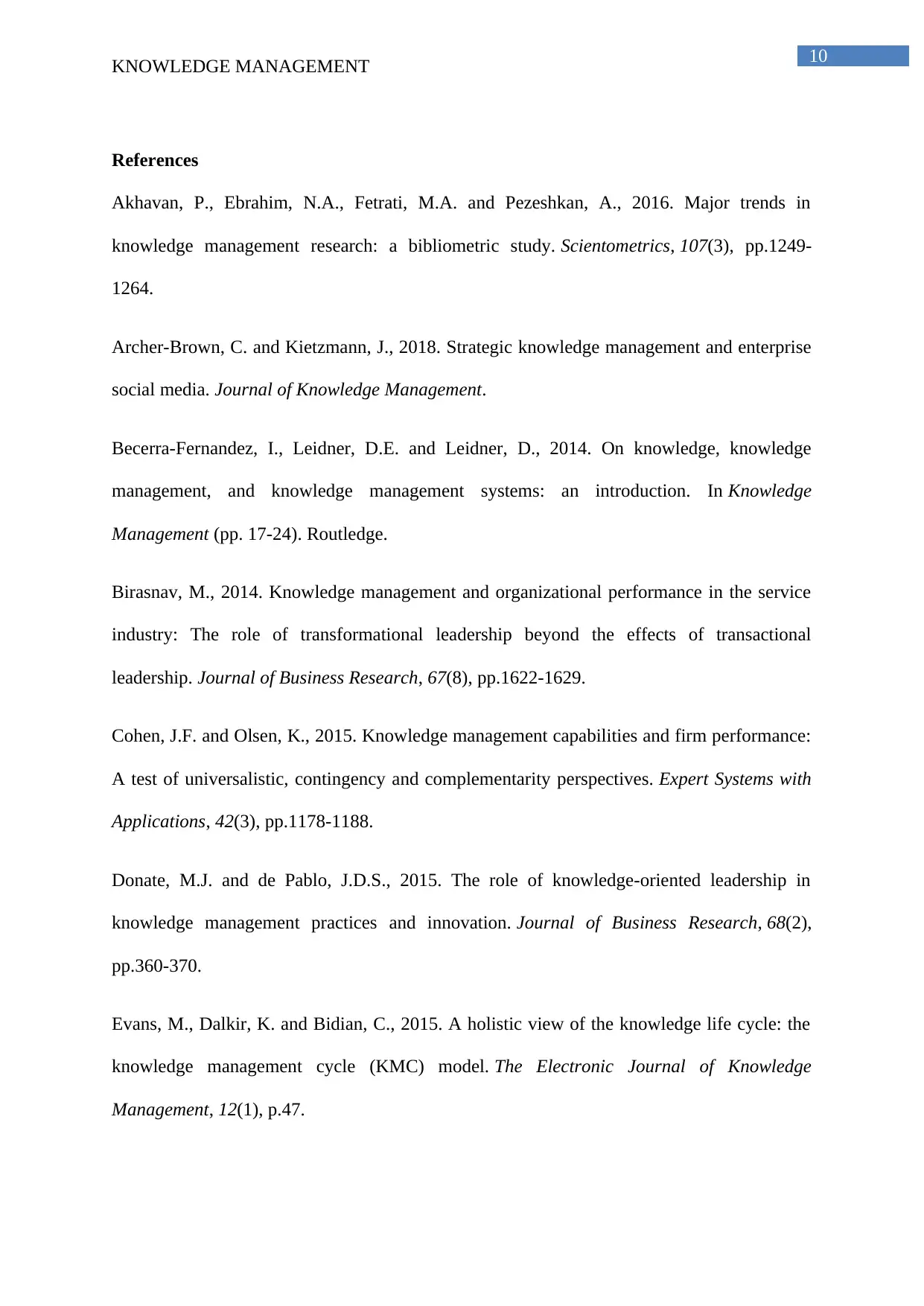
10
KNOWLEDGE MANAGEMENT
References
Akhavan, P., Ebrahim, N.A., Fetrati, M.A. and Pezeshkan, A., 2016. Major trends in
knowledge management research: a bibliometric study. Scientometrics, 107(3), pp.1249-
1264.
Archer-Brown, C. and Kietzmann, J., 2018. Strategic knowledge management and enterprise
social media. Journal of Knowledge Management.
Becerra-Fernandez, I., Leidner, D.E. and Leidner, D., 2014. On knowledge, knowledge
management, and knowledge management systems: an introduction. In Knowledge
Management (pp. 17-24). Routledge.
Birasnav, M., 2014. Knowledge management and organizational performance in the service
industry: The role of transformational leadership beyond the effects of transactional
leadership. Journal of Business Research, 67(8), pp.1622-1629.
Cohen, J.F. and Olsen, K., 2015. Knowledge management capabilities and firm performance:
A test of universalistic, contingency and complementarity perspectives. Expert Systems with
Applications, 42(3), pp.1178-1188.
Donate, M.J. and de Pablo, J.D.S., 2015. The role of knowledge-oriented leadership in
knowledge management practices and innovation. Journal of Business Research, 68(2),
pp.360-370.
Evans, M., Dalkir, K. and Bidian, C., 2015. A holistic view of the knowledge life cycle: the
knowledge management cycle (KMC) model. The Electronic Journal of Knowledge
Management, 12(1), p.47.
KNOWLEDGE MANAGEMENT
References
Akhavan, P., Ebrahim, N.A., Fetrati, M.A. and Pezeshkan, A., 2016. Major trends in
knowledge management research: a bibliometric study. Scientometrics, 107(3), pp.1249-
1264.
Archer-Brown, C. and Kietzmann, J., 2018. Strategic knowledge management and enterprise
social media. Journal of Knowledge Management.
Becerra-Fernandez, I., Leidner, D.E. and Leidner, D., 2014. On knowledge, knowledge
management, and knowledge management systems: an introduction. In Knowledge
Management (pp. 17-24). Routledge.
Birasnav, M., 2014. Knowledge management and organizational performance in the service
industry: The role of transformational leadership beyond the effects of transactional
leadership. Journal of Business Research, 67(8), pp.1622-1629.
Cohen, J.F. and Olsen, K., 2015. Knowledge management capabilities and firm performance:
A test of universalistic, contingency and complementarity perspectives. Expert Systems with
Applications, 42(3), pp.1178-1188.
Donate, M.J. and de Pablo, J.D.S., 2015. The role of knowledge-oriented leadership in
knowledge management practices and innovation. Journal of Business Research, 68(2),
pp.360-370.
Evans, M., Dalkir, K. and Bidian, C., 2015. A holistic view of the knowledge life cycle: the
knowledge management cycle (KMC) model. The Electronic Journal of Knowledge
Management, 12(1), p.47.
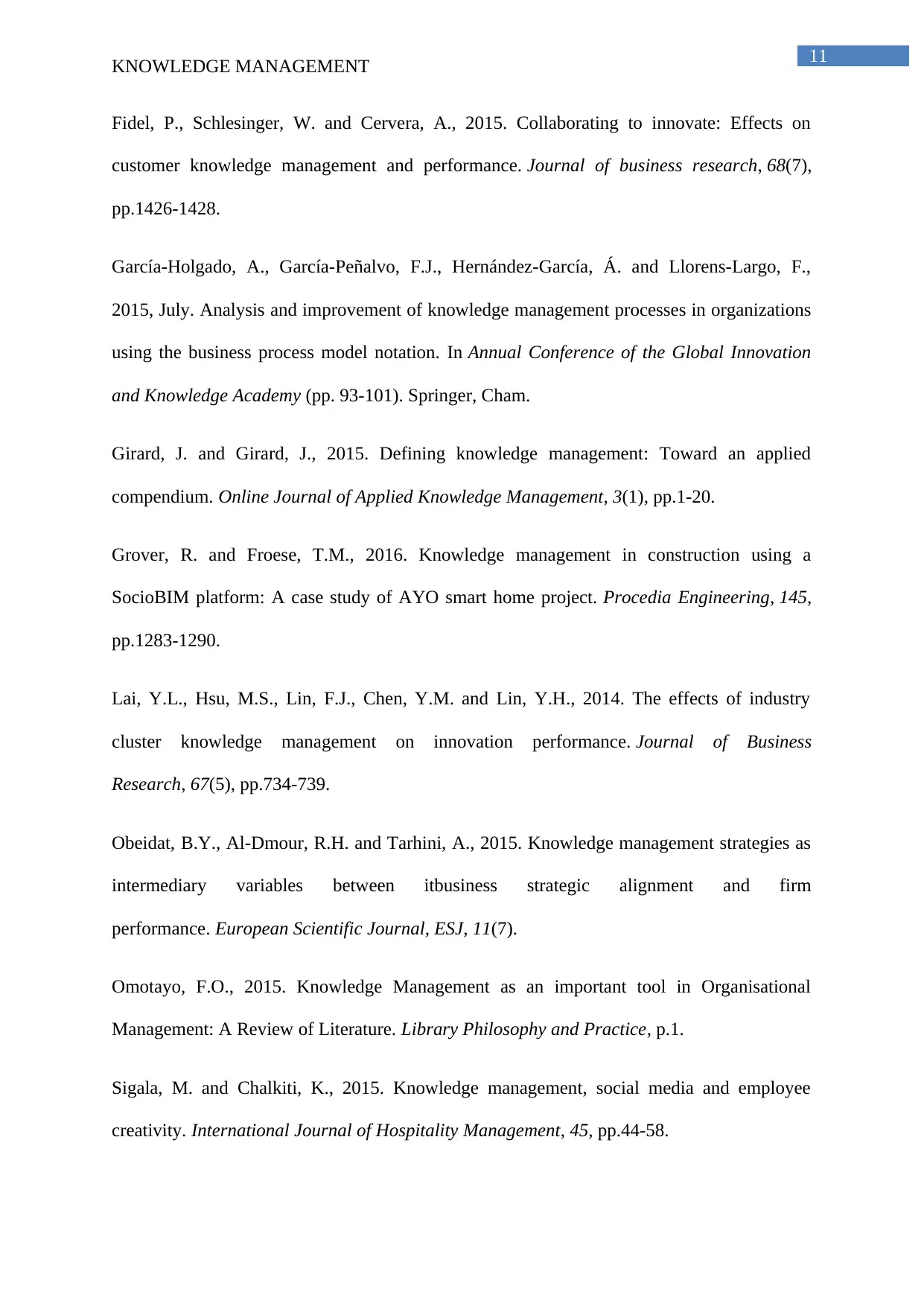
11
KNOWLEDGE MANAGEMENT
Fidel, P., Schlesinger, W. and Cervera, A., 2015. Collaborating to innovate: Effects on
customer knowledge management and performance. Journal of business research, 68(7),
pp.1426-1428.
García-Holgado, A., García-Peñalvo, F.J., Hernández-García, Á. and Llorens-Largo, F.,
2015, July. Analysis and improvement of knowledge management processes in organizations
using the business process model notation. In Annual Conference of the Global Innovation
and Knowledge Academy (pp. 93-101). Springer, Cham.
Girard, J. and Girard, J., 2015. Defining knowledge management: Toward an applied
compendium. Online Journal of Applied Knowledge Management, 3(1), pp.1-20.
Grover, R. and Froese, T.M., 2016. Knowledge management in construction using a
SocioBIM platform: A case study of AYO smart home project. Procedia Engineering, 145,
pp.1283-1290.
Lai, Y.L., Hsu, M.S., Lin, F.J., Chen, Y.M. and Lin, Y.H., 2014. The effects of industry
cluster knowledge management on innovation performance. Journal of Business
Research, 67(5), pp.734-739.
Obeidat, B.Y., Al-Dmour, R.H. and Tarhini, A., 2015. Knowledge management strategies as
intermediary variables between itbusiness strategic alignment and firm
performance. European Scientific Journal, ESJ, 11(7).
Omotayo, F.O., 2015. Knowledge Management as an important tool in Organisational
Management: A Review of Literature. Library Philosophy and Practice, p.1.
Sigala, M. and Chalkiti, K., 2015. Knowledge management, social media and employee
creativity. International Journal of Hospitality Management, 45, pp.44-58.
KNOWLEDGE MANAGEMENT
Fidel, P., Schlesinger, W. and Cervera, A., 2015. Collaborating to innovate: Effects on
customer knowledge management and performance. Journal of business research, 68(7),
pp.1426-1428.
García-Holgado, A., García-Peñalvo, F.J., Hernández-García, Á. and Llorens-Largo, F.,
2015, July. Analysis and improvement of knowledge management processes in organizations
using the business process model notation. In Annual Conference of the Global Innovation
and Knowledge Academy (pp. 93-101). Springer, Cham.
Girard, J. and Girard, J., 2015. Defining knowledge management: Toward an applied
compendium. Online Journal of Applied Knowledge Management, 3(1), pp.1-20.
Grover, R. and Froese, T.M., 2016. Knowledge management in construction using a
SocioBIM platform: A case study of AYO smart home project. Procedia Engineering, 145,
pp.1283-1290.
Lai, Y.L., Hsu, M.S., Lin, F.J., Chen, Y.M. and Lin, Y.H., 2014. The effects of industry
cluster knowledge management on innovation performance. Journal of Business
Research, 67(5), pp.734-739.
Obeidat, B.Y., Al-Dmour, R.H. and Tarhini, A., 2015. Knowledge management strategies as
intermediary variables between itbusiness strategic alignment and firm
performance. European Scientific Journal, ESJ, 11(7).
Omotayo, F.O., 2015. Knowledge Management as an important tool in Organisational
Management: A Review of Literature. Library Philosophy and Practice, p.1.
Sigala, M. and Chalkiti, K., 2015. Knowledge management, social media and employee
creativity. International Journal of Hospitality Management, 45, pp.44-58.
⊘ This is a preview!⊘
Do you want full access?
Subscribe today to unlock all pages.

Trusted by 1+ million students worldwide
1 out of 13
Related Documents
Your All-in-One AI-Powered Toolkit for Academic Success.
+13062052269
info@desklib.com
Available 24*7 on WhatsApp / Email
![[object Object]](/_next/static/media/star-bottom.7253800d.svg)
Unlock your academic potential
Copyright © 2020–2025 A2Z Services. All Rights Reserved. Developed and managed by ZUCOL.





